英语上册七年级Unit 1 My name’s Gina第3课时导学案新版人教新目标版
- 格式:doc
- 大小:59.50 KB
- 文档页数:3
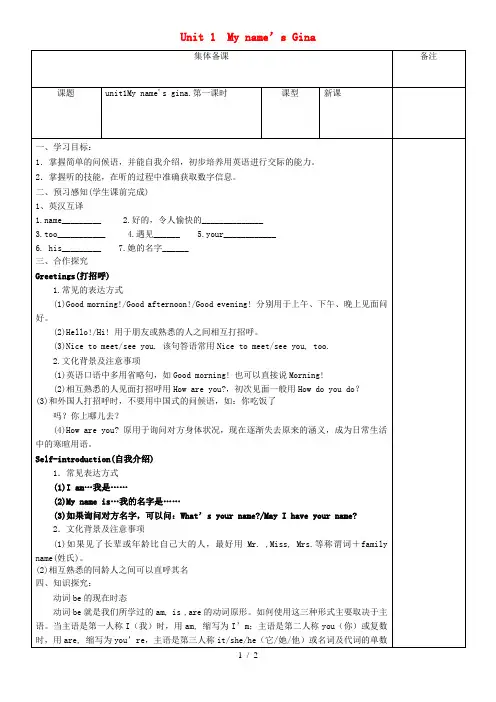
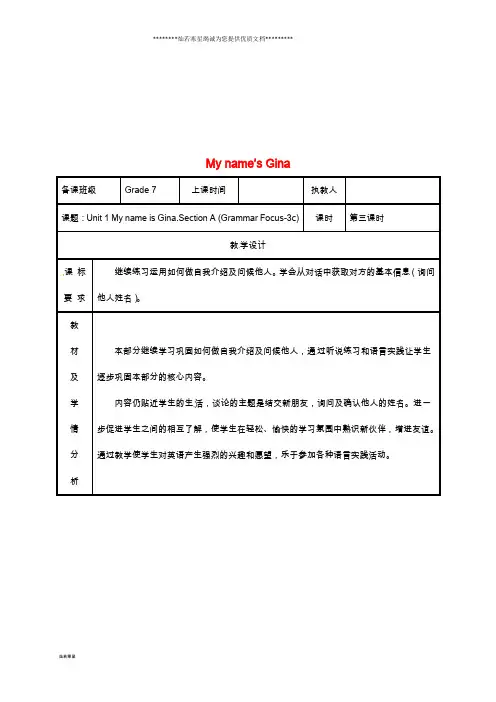
My name’s Gina
学设计
课标
过听说练习和语言实践让学生内容仍贴近学生的生
My/his her name is
sn 会运用所学的句型询问第
1. 阅读指导:老师总结已学过认识新朋友的两类句型。
2. 学生阅读Grammar Focus中的句子,然后做填空练习。
你的名字叫什么?_______ your _______?
我的名字叫艾伦。
_____ _______ Alan.
3. 注意以下几种缩略的表达法:what’s = what is, name’s = name is, I’m = I am,he’s = he is, she’s = she is
4. 学生识记后,做填空练习来进行巩固。
5. 老师对人称代词及形容词性物主代词的简单用法进行小结。
6.学生复习理解掌握所学的知识并做巩固巩固练习。
3.Ss act out
s your name? s; n ame;。
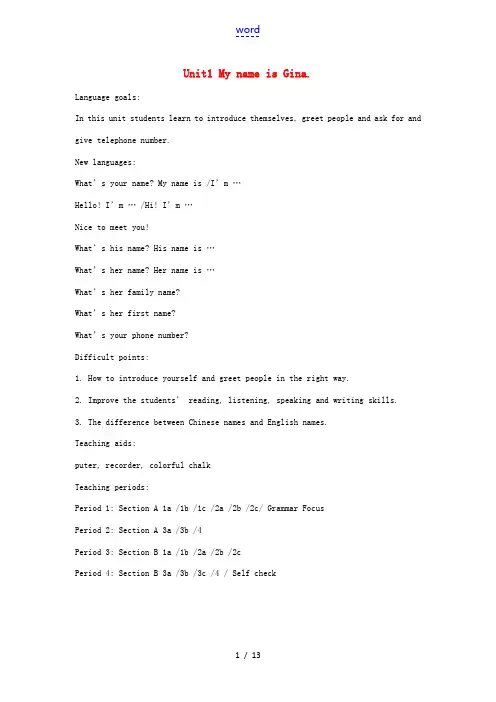
Unit1 My name is Gina.Language goals:In this unit students learn to introduce themselves, greet people and ask for and give telephone number.New languages:What’s your name? My name is /I’m …Hello! I’m … /Hi! I’m …Nice to meet you!What’s his name? His name is …What’s her name? Her name is …What’s her family name?What’s her first name?What’s your phone number?Difficult points:1. How to introduce yourself and greet people in the right way.2. I mprove the students’ reading, listening, speaking and writing skills.3. The difference between Chinese names and English names.Teaching aids:puter, recorder, colorful chalkTeaching periods:Period 1: Section A 1a /1b /1c /2a /2b /2c/ Grammar FocusPeriod 2: Section A 3a /3b /4Period 3: Section B 1a /1b /2a /2b /2cPeriod 4: Section B 3a /3b /3c /4 / Self checkPeriod 1Teaching aims:1. Memorize the words on page1and page2.2. Learn the target languages:My name is Gina.What’s your name?Hello! I’m Mary.Hi! I’m Jim.What’s his name?What’s her name?3. Train the listening and speaking skills.Teaching procedure:Step 1 Free talkLet students talk in pairs using the sentences they’ve learned in Starter or ask some questions in Starter, have students answer them. For example: Good morning/afternoon/evening!How are you?What’s this in English?What color is it?Step 2 Section A 1aThis activity tests students’ vocabulary.1. Draw student’s attention to the pictures. Point to an object in it andask what it is. Say, now look at the picturesand write down as many words as you can2. Ask two students to write the words on the blackboard.3. Check the students’ answers. Ask some students to call out their wordsand spell them. Write down the words on the board.Step3 Section A 1bThis activity gives students practice in understanding the target language in spoken conversation.Read the instruction to the students. Make sure the students understand how to do it. Say, now listen and number the conversations 1-3.(1) Play the recording for the first time. Students only listen.(2) Play the recording a second time. Students number the conversations.(3) Check the answers together.Step 4 Section A 1cThis activity provides guided oral practice using the target language.(1) Ask three pairs to read the conversations in 1b. If necessary, ask studentsto repeat the names after the teacher.(2) Have students work in pairs to practice the conversations.(3) Say, Now use your own names when you have conversations .Move around theroom monitoring their work. Offer language or pronunciation support asneeded.(4) Let several pairs e to the front of the class and act out theirconversations.Step 5 Section A 2aThis activity gives students practice in understanding the key words and target languages.1. Point to a boy and a girl. Say, His name is---, her name is--- Have studentsunderstand the meaning of his and her.2. Read the instruction to the students.3. Play the recording for the first time. Students only listen.4. Play the recording a second time. Students number the pictures 1-4.5. Check the answers.Step 6Section A 2bThis activity provides listening practice.(1) Have one student read the names in the box.(2) Say, listen to the four conversations again.This time circle the names you hear.(3) Students listen and circle the names.(4) Check the answers.Step 7 Section A 2cThis activity provides guided oral practice using the target language.(1) Call attention to the two conversations in the box.Ask one pair to act out the first one. Tell them to use their own names.Ask another pair to act out the second one.Have them point to a boy or a girl when they ask the questions:What’s his name/What’s her name?(2) Let students work in pairs to practice the two conversations. As studentswork, move around the classroom, monitoring the conversations andoffering assistance if necessary.(3) Have several pairs of students present their conversations to the class. Step 8Grammar Focus(1) Divide the class into two groups to say the questions and responses.(2) Write down the full forms and contractions of the words on the right.Have students pare them. Then ask them to say the sentences in two ways. Step 9 Conclusion(1) Learn the words and phrases.(2) Master the target languages:My name is Gina.What’s your name?Hello! I’m Mary.Hi! I’m Jim.What’s his name?What’s her name?Step 10 Homework(1) Learn the words by heart.(2) Practice the conversations in 1b and Grammar Focus.(3) Do some preparing.Period 2Teaching aims:1. Memorize the words and phrases: first, first name, last, last name, boy, girl2. Learn about first name and last name.3. Train writing and speaking skills.Teaching procedure:Step 1 Revision1. Go over the words in last class. (Play a game. Divide the class into twogroups: boys and girls. Give them three minutes to read and write the words.Then look at the Chinese meaning on the cards. See which group can say andspell the words more quickly and correctly. )2. Ask students to make conversations about introduction and greeting. Step 2 SectionA 3aThis activity introduces the western concept of first name and last name.1. Write down a Chinese name and an English name on the board. For example:Deng Yaping and Jim Smith.2. Ask students to discuss the names. Encourage them to tell the differencebetween them. (English names are listed with the given name first and thefamily name or surname second. While Chinese names are listed with thefamily name first and given name second.)3. Ask some students to say their family names and first names.4. Have two students read the list of names in the box. Say, Guess, whichnames are first names and which are last names?5. Ask students to write F for first name and L for last name next to thewords. Students do the exercise by themselves.6. Check the answers.Step3 Work in pairs(1) Call attention to the picture on the right. Students look at the pictureand the sentences carefully. Have them pay attention to what the teacherwrites.(2) Have two students read the conversations in the picture aloud.(3) Ask students to work in pairs.Ask and answer about their first names and last names.Step4 SectionA 3bThis activity provides guided oral practice using the target language.(1) Point to the names in 3a.( You can write more names on the board.)(2) Say, Which names would you like to choose as your first name and lastname? Now choose your names.(3) Have students take turns to ask and answer the questions (using theirnew names):What’s your first name?What’s your last name?Students make a list of names.Then exchange their lists to correct any mistake they make.Step5 SectionA 4 (Game)This activity gives students an opportunity to practice target language in an interesting way.1. Demonstrate the game with three students.2. Say, Now in groups of four, play the game. As they work, move around theclassroom making sure students understand the procedure and correcting anymistake.3. Ask two groups to present their games to the class.Step 6 Conclusion(1) Learn the words and phrases in this class.(2) Grasp the target languages:What’s your first name?What’s your last name?Step 7 Homework(1) Memorize the words and phrases.(2) Make a conversation about asking for first name and last name.(3) Prepare next lesson.Period 3Teaching aims:1. Memorize the words on page4.2. Target languages:What’s your phone number?It’s …3. Train the listening and speaking skills.Teaching procedure:Step 1 Free talkLet students work in pairs. Make conversations using the target languages they’ve learned. For example:What’s your name? My name is …What’s his name? His name is …What’s her name? Her name is …What’s your first name?What’s your last name?Step 2 Section B 1aThis activity learns the numbers from 0 to nine.(1) Write the numbers 0-9 on the board. Ask who can say them in English.Encourage more students to read them.(2) Play the recording for the first time. Students only listen.(3) Play the recording a second time. Have students repeat the numbers.(4) Give students two or three minutes to read and write the mummers. Thenhave some students say them quickly and ask if anybody can spell them.Cheer for the students who do best.Step3 Section B 1bThis activity gives students practice recognizing the numbers 0-9 in spoken telephone numbers.Say, Now listen to the conversation, and write down the telephone number you hear.(1) Play the recording for the first time. Students only listen.(2) Play the recording a second time.Have students write the numbers in the blank.(3)Check the answers.(4) Work in pairs and practice the conversation.Step 4 Section B 1cThis activity gives students speaking practice using the target language.(1) Call attention to the conversation on the right. Have two students read it.(2) Practice the conversation in pairs.(3) Say,Now in groups of three or four, make up conversations using any phonenumber you like .As they work, move around the room monitoring their work.Offer language or pronunciation support as needed.(4) Let several pairs e to the front of the class to perform theirconversations for the class.Step 5 Section B 2aThis activity provides listening practice with the target language.1. Call attention to the names and the numbers in the box.2. Read each one to the class or ask some students to read them.3. Point to the blanks in the four telephone numbers. Say, The phone numbersaren’t finished. You need to write the last two numbers later. Now listenand match the names with the telephone numbers.4. Play the recording for the first time. Students only listen.5. Play the recording a second time Students write the letter of the person’stelephone number in the space after that person’s name.6. Check the answers.Step 6Section B 2bThis activity gives students practice recognizing the spoken numbers 0-9. (1) Say, Now let’s listen to the conversations again and finish each telephonenumber.(2) Students listen and fill in the missing numbers.(3) Check the answers.(4) If have time, have students repeat the telephone number after the recording.(5) Practice the four conversations in pairs.Step 7 Section B 2cThis activity provides guided oral practice using the target language.(1) Call attention to the address book. Ask one student,“What’s your phone number?” Write his/her name and phone number inthe address book.Make sure all the students understand how to fill in the address book.(2) Say, Now ask your four classmates their phone numbers and fill in theform.Step 8 Conclusion(1) Learn the numbers 0-9.(2) How to asking for phone number:What’s your phone number?It’s …Step 9 Homework(1) Remember the numbers from 0 to 9.(2) Make two conversations.(3) Do some preparing.Period 4Teaching aims:1. Memorize the words and phrases on page2. How to ask for first names/last names/phone numbers.3. Train speaking and writing skills.Teaching procedure:Step 1 Revision1. Go over the numbers in last class.Ask the students to read and spell numbers from 0-9.2. Talk about phone numbers.Step 2 Section B 3aThis activity reviews about first name and last name.1. Say, Look at the picture. How many cards can you see?Can you read the names on the card?2. Ask four students to read the names on each card. Then say,“Which is first name and which is last name? Do you know?”3. Point out the blank line following each first name in the exercise.Say, Write each person’s last name in the blank after the first name.4. Students finish the exercise individually.5. Check the answers.Step 3 Section B 3b & 3cThis activity provides speaking and writing practice using the target language.(1) Point to the ID card. Say, Look at the girl on the card. What’s hertelephone number? What’s her family name? What’s her first name?(2) Have students work in pairs and answer the three questions.(3) Check the answers.(4) Say, Look at the ID card in 3c. This is your card. Write your own firstname, last name, and telephone number on it.(5) As students work, move around the room checking progress.Step 4 Section B 4This activity gives students an opportunity to practice target language ina game.Read the instruction to the class. Make sure all the students know how to do it. Move around the room monitoring their work. Offer language or pronunciation support as needed.。
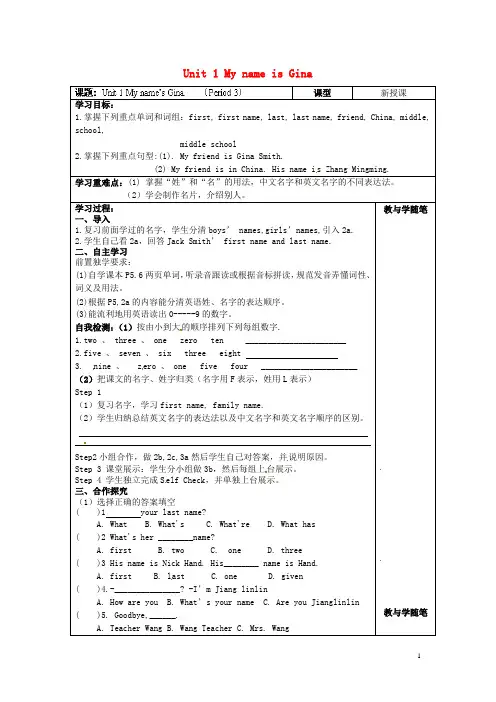
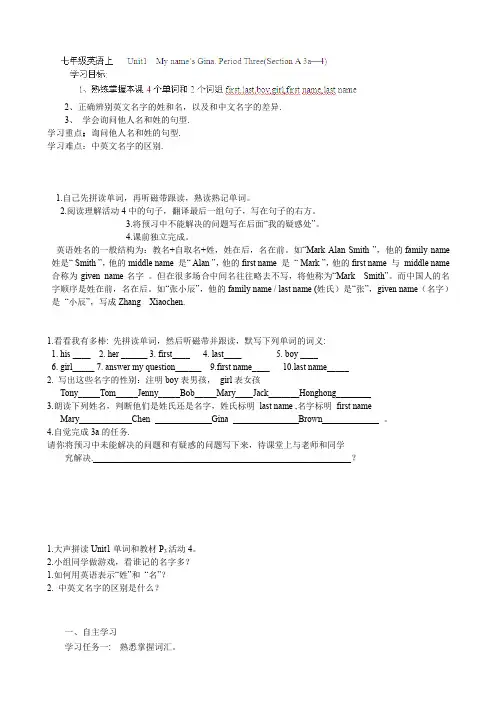
2、正确辨别英文名字的姓和名,以及和中文名字的差异.3、学会询问他人名和姓的句型.学习重点:询问他人名和姓的句型.学习难点:中英文名字的区别.1.自己先拼读单词,再听磁带跟读,熟读熟记单词。
2.阅读理解活动4中的句子,翻译最后一组句子,写在句子的右方。
3.将预习中不能解决的问题写在后面“我的疑惑处”。
4.课前独立完成。
英语姓名的一般结构为:教名+自取名+姓,姓在后,名在前。
如“Mark Alan Smith ”,他的family name 姓是“ Smith ”,他的middle name 是“ Alan ”,他的first name 是“ Mark ”,他的first name 与middle name 合称为given name名字。
但在很多场合中间名往往略去不写,将他称为“Mark Smith”。
而中国人的名字顺序是姓在前,名在后。
如“张小辰”,他的family name / last name (姓氏)是“张”,given name(名字)是“小辰”,写成Zhang Xiaochen.1.看看我有多棒: 先拼读单词,然后听磁带并跟读,默写下列单词的词义:1. his ____2. her ______3. first____4. last____5. boy ____6. girl_____7. answer my question______ 9.first name____ st name_____2. 写出这些名字的性别:注明boy表男孩,girl表女孩Tony_____Tom_____Jenny_____Bob_____Mary____Jack_______Honghong______3.朗读下列姓名,判断他们是姓氏还是名字,姓氏标明last name ,名字标明first nameMary Chen Gina Brown 。
4.自觉完成3a的任务.请你将预习中未能解决的问题和有疑惑的问题写下来,待课堂上与老师和同学究解决. ?1.大声拼读Unit1单词和教材P3活动4。

七年级英语上册Unit 1 My name’s Gina教案(新版)人教新目标版编辑整理:尊敬的读者朋友们:这里是精品文档编辑中心,本文档内容是由我和我的同事精心编辑整理后发布的,发布之前我们对文中内容进行仔细校对,但是难免会有疏漏的地方,但是任然希望(七年级英语上册Unit 1 My name’s Gina教案(新版)人教新目标版)的内容能够给您的工作和学习带来便利。
同时也真诚的希望收到您的建议和反馈,这将是我们进步的源泉,前进的动力。
本文可编辑可修改,如果觉得对您有帮助请收藏以便随时查阅,最后祝您生活愉快业绩进步,以下为七年级英语上册Unit 1 My name’s Gina教案(新版)人教新目标版的全部内容。
Unit 1 My name’s Gina.The First PeriodSection A (1a—2d)Ⅰ.Teaching aims:1.Knowledge aims:(1)Key words:name,nice,to,meet,too,your,Ms.,his,and,her,yes,she,he,no,not(2)Key phrases:Nice to meet you.(3)Important sentences:①—What’s your/his/her name?—My/His/Her name is .。
②—Nice to meet you.—Nice to meet you,too.2.Ability aims:Introduce yourself and greet people。
3.Emotion aims:Improve students’ conversation skills。
II.Important points:The usage of pronouns。
III。
Difficult points:Grasp the usage of pronouns.IV。
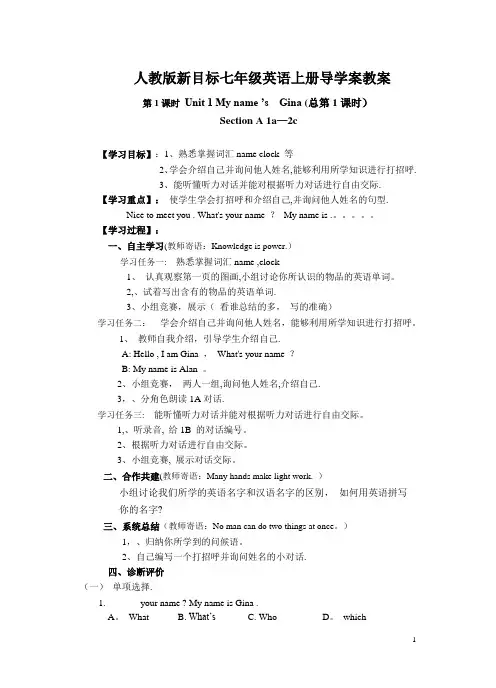
人教版新目标七年级英语上册导学案教案第1课时Unit 1 My name ’s Gina (总第1课时)Section A 1a—2c【学习目标】:1、熟悉掌握词汇name clock 等2、学会介绍自己并询问他人姓名,能够利用所学知识进行打招呼.3、能听懂听力对话并能对根据听力对话进行自由交际.【学习重点】:使学生学会打招呼和介绍自己,并询问他人姓名的句型.Nice to meet you . What's your name ?My name is .。
【学习过程】:一、自主学习(教师寄语:Knowledge is power.)学习任务一: 熟悉掌握词汇name ,clock1、认真观察第一页的图画,小组讨论你所认识的物品的英语单词。
2,、试着写出含有的物品的英语单词.3、小组竞赛,展示(看谁总结的多,写的准确)学习任务二:学会介绍自己并询问他人姓名,能够利用所学知识进行打招呼。
1、教师自我介绍,引导学生介绍自己.A: Hello , I am Gina ,What's your name ?B: My name is Alan 。
2、小组竞赛,两人一组,询问他人姓名,介绍自己.3,、分角色朗读1A对话.学习任务三: 能听懂听力对话并能对根据听力对话进行自由交际。
1,、听录音, 给1B 的对话编号。
2、根据听力对话进行自由交际。
3、小组竞赛, 展示对话交际。
二、合作共建(教师寄语:Many hands make light work. )小组讨论我们所学的英语名字和汉语名字的区别,如何用英语拼写你的名字?三、系统总结(教师寄语:No man can do two things at once。
)1,、归纳你所学到的问候语。
2、自己编写一个打招呼并询问姓名的小对话.四、诊断评价(一)单项选择.1. _______your name ? My name is Gina .A。
What B. What’s C. Who D。
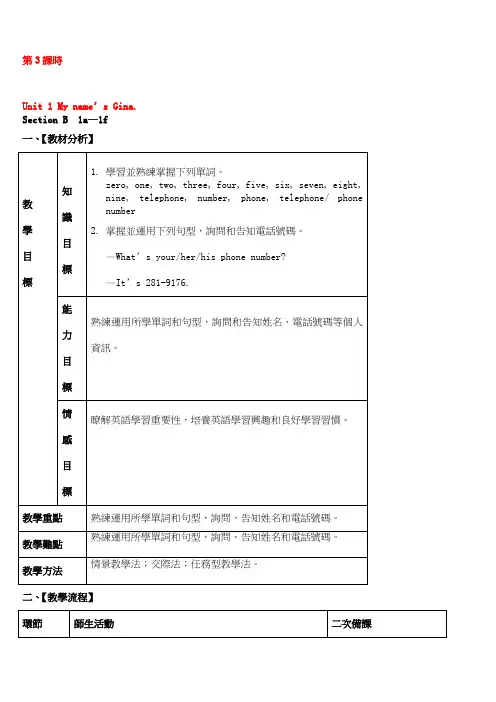
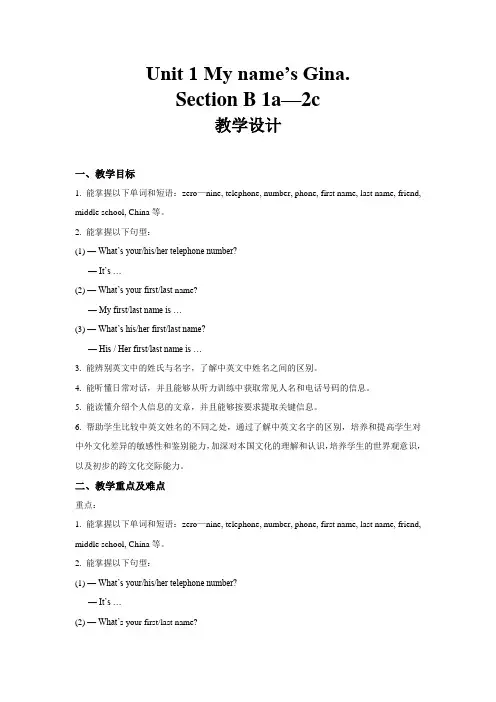
Unit 1 My name’s Gina.Section B 1a—2c教学设计一、教学目标1. 能掌握以下单词和短语:zero—nine, telephone, number, phone, first name, last name, friend, middle school, China等。
2. 能掌握以下句型:(1) —What’s your/his/her telephone number?—It’s …(2) —What’s your first/last name?—My first/last name is …(3) —What’s his/her first/last name?—His / Her first/last name is …3. 能辨别英文中的姓氏与名字,了解中英文中姓名之间的区别。
4. 能听懂日常对话,并且能够从听力训练中获取常见人名和电话号码的信息。
5. 能读懂介绍个人信息的文章,并且能够按要求提取关键信息。
6. 帮助学生比较中英文姓名的不同之处,通过了解中英文名字的区别,培养和提高学生对中外文化差异的敏感性和鉴别能力,加深对本国文化的理解和认识,培养学生的世界观意识,以及初步的跨文化交际能力。
二、教学重点及难点重点:1. 能掌握以下单词和短语:zero—nine, telephone, number, phone, first name, last name, friend, middle school, China等。
2. 能掌握以下句型:(1) —What’s your/his/her telephone number?—It’s …(2) —What’s your first/last name?—My first/last name is …(3) —What’s his/her first/last name?—His / Her first/last name is …3. 能辨别英文中的姓氏与名字,了解中英文中姓名之间的区别。
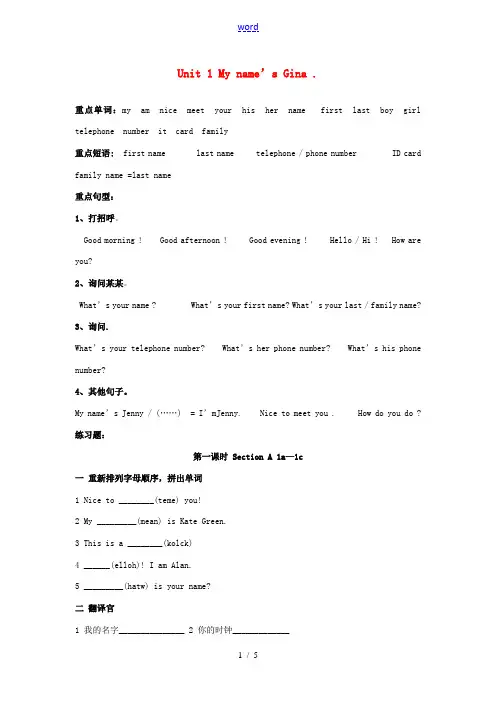
Unit 1 My name’s Gina .重点单词:my am nice meet your his her name first last boy girl telephone number it card family重点短语: first name last name telephone / phone number ID card family name =last name重点句型:1、打招呼。
Good morning ! Good afternoon ! Good evening ! Hello / Hi ! How areyou?2、询问某某。
What’s your name ? What’s your first name? What’s your last / family name?3、询问.What’s your telephone number? What’s her phone number? What’s his phone number?4、其他句子。
My name’s Jenny / (……) = I’mJenny. Nice to meet you . How do you do ?练习题:第一课时 Section A 1a—1c一重新排列字母顺序,拼出单词1 Nice to ________(teme) you!2 My _________(mean) is Kate Green.3 This is a ________(kolck)4 ______(elloh)! I am Alan.5 _________(hatw) is your name?二翻译官1 我的名字_______________2 你的时钟_____________3 见到你真高兴_____________________三单项选择( ) 1 ---- Good morning!----______________A ByeB Good morningC Good luck( ) 2 ----Hello, Ann! How are you?---- ________________A How are you?B Nice to meet youC Fine, thanks. ( ) 3 ---- Hi, Jenny! Nice to meet you!---- _______________________A YesB Nice to meet you, tooC Good morning ( ) 4 ----________, What’s your name?---- Mary JonesA HiB OhC OK四根据汉语完成句子1 你叫什么名字?________ ________ name?2 很高兴见到你。
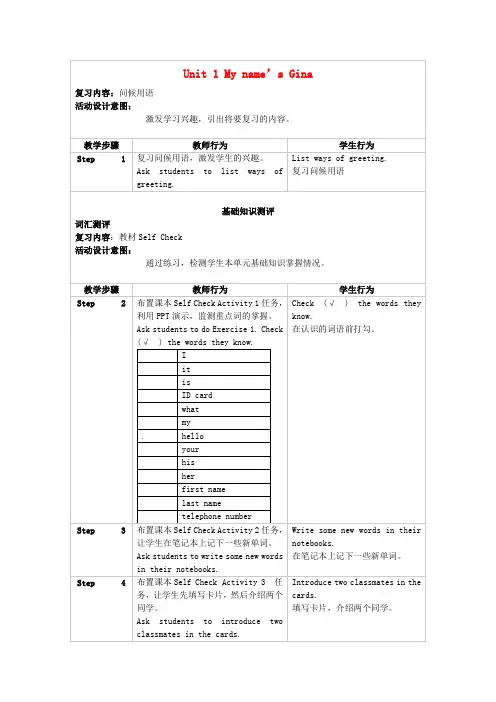
Self Check Activity 3在班上作口头介绍。
可以组织学生进行游戏竞赛活基础句型学习评价1. What’s her last name? ___________________________________2. What’s her first name? ___________________________________3. What’s her telephone number? ___________________________________Key:1. Her last name is Green.2. Her first name is Gina.3. Her telephone number is 398762.Key: I have a friend. Her name is Helen Miller. Her first name is Helen. Her last name is Miller. She is 12 years old. Her telephone number is 860395. She is in Class 2. Her e-mail address is helen@.单元知识达标学习效果评价一、圈出下面对话中的名字。
相同的名字只圈一次。
A: Hi, Kate. How are you?B: Fine, thanks. And you?A: I’m great. Oh, Kate, this is my friend, Bill.B: Hi, Bill, I’m Kate. Nice to meet you.A: Nice to meet you, too, Kate.A: Good morning, Miss Lee.B: Good morning, Karen. How are you this morning?A: Very well, thank you.B: Oh, this is Mr Clark.A: Nice to meet you, Mr Clark. My name is Karen.B: Nice to meet you, Karen.二、用英语写出数字0-10。
Unit 1 My name’s Gina一.学习目标:1.准确拼读并掌握下列词汇:数字0-9 ,telephone ,number ,phone ,it.2.学会询问和给出电话号码,培养学生好的交际的能力,融洽同学关系。
-What’s your telephone/phon e number? –It’s…二.学习重难点:重点:拼读和书写表达数字的单词。
难点:正确流利地询问电话号码和给出电话号码。
三.使用说明:1.自学指导:(1)先独立拼读单词,小组内相互纠正读音,然后记忆,组长检查听写过关。
(2)准备好各自的电话号码(把名字和电话号码写在小卡片上),练习询问同学的电话号码的对话并完成2c的表格。
(3)独立完成导学案并按时上交。
2.正课课堂流程:(1)课前单词复习检测(5分钟)(2)对话展示和听力(1b,2a and2b)(20分钟)(3) 导学案讨论释疑(15分钟)(4)整理背诵记忆(5分钟)四.自学检测:1.默写英语数字1-9.2. 用英语写出下列电话号码:1)66320528 2)725683193)272315464)1386524768 3.从B栏中找出与A栏相对应的答语。
A B( ) 1.Hello,I’m Mary. A.I’m Mary.Nice to meet you.( )2.What’s his name? B.Hi,Mary.I’m Jim.( )3.My name is Jenny. C.Her name is Linda.( )4. What is her name? D.His name is Bob.( )5.What’s her telephone number? E.It’s 283-0531.4.用所给词语的正确形式填空:1).His name_________(be) Johnson.2)._________(I )name is Mike.3)It’s__________(a) orange.4)This is___________(she) key.5)He is my brother(弟弟).__________(he)name is Jim.5.根据要求做句型转换:1)My name is Jack.(对划线部分提问)2)I’m Jim.(改为同意句)_________ __________ ____________Jim.3)She is Gina.(用I改写句子)___________ __________Gina.4)My telephone number is 678459. (对划线部分提问)______________ ____________telephone number?6. 完成对话,每空一词。
Unit 1 My name’s Gina. Section A(1a-2d)课时1班级:姓名:学号:【学习目标】一、Key words: name; nice; meet; your; his; and;二、Main sentences: My name’s Gina. What’s your name?I’m Jenny. Nice to meet you.三、Teaching important points: How to greet people?【预习内容】一、根据汉语提示填单词完成句。
1.The ruler is red (和)yellow.2.What’s (你的)name?3.She is (不是)Alan.4.Nice to (遇见)you.5.My (名字)is Alan.二、根据汉语完成句子,每空一词。
1.—你叫什么名字?--我叫吉姆。
-- your name?-- Jim。
2.见到你很高兴。
to you.3.她的名字叫吉娜。
Gina。
4.这是我的妈妈。
This mother.5.我在七(二)班。
in Class Two, Grade Seven.三、通过预习,你的疑问是【学习过程】1.通过跟学生对话,引出本节课的主要单词和句型。
2.看图上的小对话,学习并练习对话1a:- What’s your/her/his name?-My/Her/His name’s…--I’m ….. / He’s…. /She’s…. 。
3.听力练习:1a-2b。
4.合作探究:1)What’s your name?的另外一种问法是,它的答语都有2)Nice to meet you.的答语是,除此之外的问候语还有它的同义句有3)总结be动词口诀:5.2c: Practice the conversations in pairs. Then make your own conversations.【课堂作业】一、用am, is, are将下列句子填补完整。
教学案例Unit1 My name’s Gina.( Section A)教材分析:教学内容为《新目标》英语7年级上册Unit1,Section A。
学习内容主要体现以下几点:1.掌握介绍自己和问候他人的句型:What’s your name? My name’s Gina. Nice to meet you!2.掌握Be的一般现在时形式3.掌握What引导的特殊疑问句4.掌握形容词性物主代词:my, your, his, her能力目标:1.通过教学,引导学生学会问候他人和学会如何做自我介绍;能从对话中获取对方的基本信息;建立班级电话号码簿;学会制作个性名片;能向他人简单地介绍自己名字的含义。
2.培养语言能力,让学生把所学到的语言知识和生活实际联系起来,使学习过程生活化。
3.学会一些基本的学习策略,听说领先,读写跟上的策略,在起始阶段反复跟读磁带,标上语调,模仿纯正的美语4.培养用英语思维的能力和创新意识,学会不断发现问题,并用自己已有的知识水平和生活经历来解决实际问题。
如个性化名片的设计,培养了学生的动手能力,展示了学生的个性。
情感目标:1.通过小组对话、讨论、调查和设计等一系列的活动,培养学生的合作意识和团队精神。
2.通过结交新朋友,学会如何礼貌地与他人交往。
交际策略:学会与他人合作交流,并能把语言材料运用到真实的生活中去。
资源策略:学会利用一切可以利用的学习资源,如词典,网络,音像资料,尤其是配套的录音材料来获取更多的信息。
认知能力:积极思考,及时反馈。
调控策略:在反思、顿悟和自醒中不断的调整自己的学习策略。
设计理念:任务型语言教学倡导“在做中学,在做中用”的教育理念,根据这理念,我将任务为中心将语言应用的基本理念转化为具有实践意义的课堂教学方式,运用学习任务组织教学,强化语言实践的过程,充分体现了语言的交际本质。
在英语课堂上,实施任务和开展活动具有很大的挑战性,需要在实际操作中对教材进行重新整合,并要根据学生的环境和接受能力来开展行之有效的任务和活动。